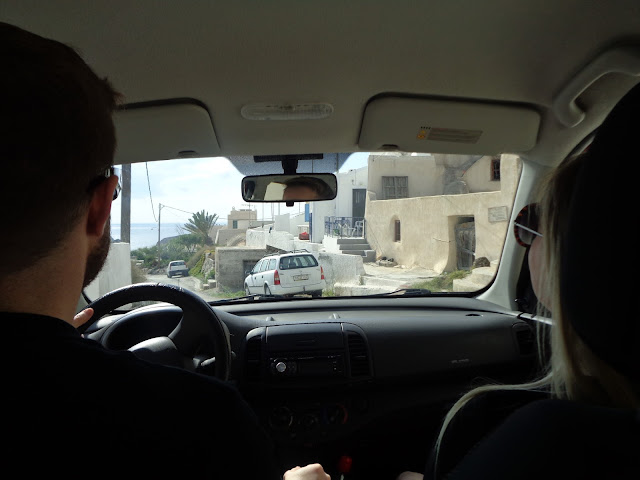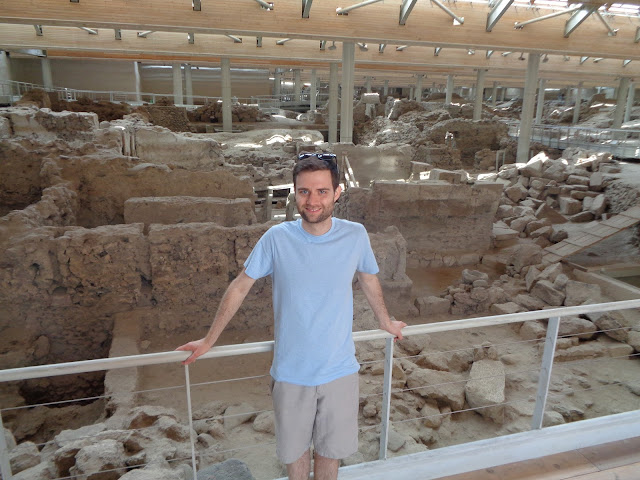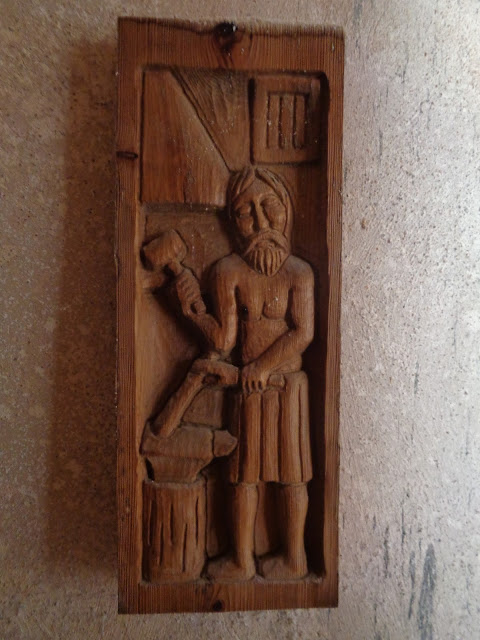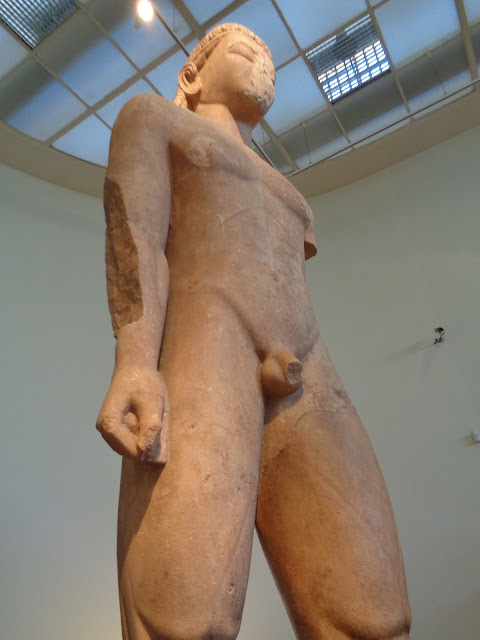There must be something in the Canadian DNA that causes us
to be perpetually baffled that parts of the world are tolerable from late
October onwards. We understand how climates and lines of latitude work, but
there’s nothing that will get a Canadian more excited than wearing shorts on
Halloween. It’s like even when you know that magician is going to pull your
card out of the deck, you’re still shocked when it happens.
So those are the opportunities that we’re wont to seek out.
Hence our escapade to Greece—a chance to reclaim one last sliver of summer. It
also didn’t hurt that it was Amber’s birthday weekend, and Greece had bucket
list caliber for her (funnily enough—and it’s only funny because it turned out
100% fine—she was the one to suggest the trip and almost the one left behind in
the departures lounge when it came time to board our flight in Amsterdam and
she had no idea where her passport was. Thank God, or maybe Dionysus, that
someone had returned it to the desk).
Granted, the temperatures were never quite as warm as we optimistically dressed for, especially in the
evenings, but that was only a minor setback. We were still on Santorini after
all, the postcard image of the Greek islands. The main island is a crescent
moon, looking down onto a bay that is, in reality, the sunken part of a long
ago volcano (the caldera—that ancient explosion likely caused a tsunami that
wiped out a prehistoric settlement on Crete and buried the city of Akroitiri on
Santorini, possibly inspiring the legend of Atlantis).
Although the island is small, easily managed by car in a single day, it still hosts a number of communities. The main settlement, Fira, sits right on the edge of a steep embankment plummeting to the caldera and the remains of the volcanic peak in the centre. It was here that we had booked three evenings at the San Giorgio Villas.
Although the island is small, easily managed by car in a single day, it still hosts a number of communities. The main settlement, Fira, sits right on the edge of a steep embankment plummeting to the caldera and the remains of the volcanic peak in the centre. It was here that we had booked three evenings at the San Giorgio Villas.
There are certain aspects of the Greek character towards
tourists that I wasn’t a huge fan of, but you’ll never catch me saying an ill word
about the hospitality industry. I don’t know how much of it might have to do
with the effects of the economic downturn in Greece, but both places we stayed
during our time in that country went above and beyond to accommodate us, even
though what we paid would get us far less in other parts of the world. In
Santorini, a shuttle van was waiting to take us to the hotel, and upon arrival
we were given a thorough overview of the island—not a sales pitch either, like
we assumed it would be. San Giorgio also provided coffee and cake every
morning, in addition to clean and modern rooms.
Come Friday morning, we figured the best plan of attack
would be to rent a car. There is a bus in Santorini that goes to all the major
spots, but the routes are simple lines, going from Fira to a destination. So,
if we wanted to go to the beach at Perissa and then to Oia, we’d have to get
four different buses. We already wasted more than enough time in transit in
Athens, and Ted didn’t mind driving a car with a manual transmission along the
impossibly narrow, winding roadways.
Once we got on the road and it was just us, the open air,
and the caldera, we couldn’t have asked for a better day. Our first stop was the
Faros Lighthouse, at the southern lip of the island, straddling the caldera and
the Aegean Sea.
The next port of call was Akrotiri. Other than the cats, it wasn’t too lively a spot—but then again, there hasn’t been anyone living in this settlement since it was destroyed in that volcano explosion in 1627 BC. Similar to a Pompeii situation, the burying of the village in volcanic ash preserved frescoes, pottery, and walls from that ancient civilization, which must have been quite sophisticated, involved in trade with other islands and implementing a sewer system in the streets.
In 1967, excavation at the site began in earnest. Now,
Akotiri is a working site, accessible to the public via suspended catwalks. The
part of the city that has been unearthed (and estimates put that at a miniscule
3% of the full settlement) is completely covered, protecting the
exposed city from the elements.
It’s amazing, to actually step back into a time that we know so little about, and where investigation is still ongoing. Many of the frescoes from the site, along with other artifacts, ended up at the Museum of Prehistoric Thera, in Fira, so we made a mental note to check them out before we left.
The midday sun, at that point, wasn’t going to be getting
much warmer, so we drove to a less-than-populated beach on the eastern edge of
the island. Judging by the amount of parking in the area and the number of
beach bars lining the streets, this place is probably out of control in July,
but at this time of the year even we were a bit iffy about getting in the water
(although Amber came back the next day and took the plunge).
At any rate, we can still say we went to the beach at the
end of October and soaked it all in. Some of us moreso than others.
The dominating point in the Santorini landscape is Profiti
Ilias, a monastery on top of the highest hill on the island. By now we’d driven
around most of Santorini, and so it was a nice treat to come up here and be
able to see the entirety of the island is one sweeping panorama and know what
it was we were looking at.
The afternoon was waning as we came down the hillside and
drove to the northern part of the island, and the settlement of Oia. Oia is
what we had in mind when we came to Santorini: whitewashed houses facing the
sea, blue-domed rooftops of churches, narrow alleyways branching in every
direction. It’s here that people flock every evening to watch the sunset—we
picked a spot out of the way from the crowd, about halfway down the hillside on
an outcrop not far from the steps that the donkeys traverse up during the day,
and watched an autumn sunset. Meaning that the sun went behind a haze at some
point in the afternoon, and the next thing we knew it just got dark.
In the twilight, we poked through the shop stalls on the
cobbled walkways of Oia, eventually stopping into Skala, a restaurant looking
out on the deepening evening and the sea far below. Like Athens, there are no
shortage of stray cats hanging around throughout the island, and this
restaurant was not exception—we had about half a dozen sets of hungry eyes
watching us eat moussaka, a cheesy casserole combining eggplant and ground beef
in a combination that I also didn’t realize I was depriving myself of.
By the time Halloween morning rolled around, we had been to
most of the major spots on the island. We’d returned the car the night before,
and Kayla and I set out on our own in Fira, to see the breathtaking views of the town overlooking the sea, and watch the donkeys make their way up the stone staircases connecting the port to the town.
Around midmorning, we visited the Lignos Folklore Museum. In a cave house from 1861—and that really does mean a house built into the side of the rock—we toured through rooms documenting the authentic, traditional way of life for people living in Santorini, led by our own personal tour guide.
Around midmorning, we visited the Lignos Folklore Museum. In a cave house from 1861—and that really does mean a house built into the side of the rock—we toured through rooms documenting the authentic, traditional way of life for people living in Santorini, led by our own personal tour guide.
We started in a living room, with large windows over the
doors to create as much light as possible in otherwise dark, cramped spaces. We
then moved through the bedrooms of the parents (complete with a rudimentary
toilet in the corner) and the children, and the storeroom for everything from
vases to cages for capturing songbirds.
The kitchen shows not just the types of earthenware dishes
that the traditional inhabitants of Santorini would have used, but also the way
in which their ovens maximized heat; those scraggly branches are the only type
of wood on the island, and even that is limited, so anything that needed
heating had to be done efficiently.
You sometimes don’t think about simple, logistical problems like that, but the reality is that we were on a small island a nice distance from anything major. Nowadays, even getting water to Santorini is a complication, given that there isn’t a natural reservoir on the island. I don
You sometimes don’t think about simple, logistical problems like that, but the reality is that we were on a small island a nice distance from anything major. Nowadays, even getting water to Santorini is a complication, given that there isn’t a natural reservoir on the island. I don
It was during our tour that I think we got an important
glimpse into life on Santorini, for real. This island is a tourist mecca—just
think about how many times you’ve seen those blue rooftops in your life. But it
wasn’t always that way—it used to be, until a few decades ago, a fairly simple
place to live and make a rudimentary living. But with the tourism boom, people
here saw huge flows of cash come in, but they also saw restaurants, bars, and
souvenir stalls open on every corner. Our guide phrased it perfectly: the
people of Santorini lost control.
I guess that’s a reality of any place going through economic
difficulties. Money can be a blessing, but what do you have to sell to get it?
Are we just part of the flock that passes through everyday, while the residents
of the island silently resent us while they rush to please?
We ventured underground then, through traditional
workspaces—including a large semi-circular basin for squashing grapes beneath
your feet, in preparation for wine.
Next, we passed through a private chapel, the likes of which
are fairly common on Santorini. The Orthodox Church still has a strong presence
on life here on the island.
As we were getting ready to leave and continue on with our
day, the owner and founder of the museum, Emmanuel Lignos, approached us with
broken English, translated via our tour guide. First and foremost, he gave a
warning: if we ever came back to Santorini, and here he pointed to me, and then
Kayla, and then his wedding finger. I’m not sure what he was getting at there.
Maybe it was because this was the last day of the season,
and we inadvertently were the last visitors to the museum for 2015. Maybe it
was because he was a lawyer before he turned folklorist, and this combination
of people couldn’t have been better suited if he’d tried. Maybe he’s just an
eccentric who runs a museum in his spare time, who can say, but he pointed to
the wall where there were hung several pieces of Santorini art, and made sure
we took something home with us. Actually, he insisted on quite a few things.
If the people of Santorini do resent the influx of tourists, they certainly don’t show it.
We spent our final day in Santorini mostly worn out and
ready to go, already dreading the commute between the Athens airport and our
Airbnb. We managed to occupy a few hours in the morning, visiting the
Prehistoric Museum and the Archaeological Museum of Thera.
Once we had seen about all the prehistoric pottery we could take, we made sure to have one last bit of moussaka.
Brought back to the airport by the hotel shuttle, they
thanked us earnestly for our stay, and I’m pretty sure they meant it, too. We
really did luck out with where we stayed on this sojourn, though by the time we
landed in Athens we all wanted to teleport ourselves to bed at all costs. We
decided to take a cab with an animated Greek man who smoked in the car and
rambled on as he cruised through the illuminated city. What a welcome sight
those beds were.
We had one last day in Greece, and now refreshed by a full
night’s sleep we set off to visit the National Archeological Museum of Athens.
I know what you’re thinking: haven’t we seen enough impossibly old stuff by
now? At what point does it all just start blending together?
Well, I think we reached the quota. The museum was fabulous,
but it was a never-ending collection of antiquities, and at some point you have
to just accept the fact that you’ve seen more history in the span of a few days
than most people see in their entire lives, and be satisfied with that.
We made one final stop in Athens, and that was at the Agora. The Ancient Agora was the assembly point of classical Athenian society, where commercial endeavours and political discourse and judicial decisions all happened. The Greeks patented democracy, after all, and some of the smartest folks of all time—Sophocles, Aristotle, Plato—likely hung out here.
We still had a few hours before our flight, but we wanted to
leave Athens while the sun was up, so that would be our parting memory of the
place. Greece ended up being a whirlwind trip, delving into the depths of
civilized history—maybe somewhat to a fault, because I think there’s something
lurking just beneath the surface in contemporary Greek society that tourists
aren’t ever totally privy to. I also think that Athens as a city is having an
identity crisis, torn between being the face of classical antiquity or moving
forward with the world in the twenty-first century. You can definitely be both,
but this city hasn’t mastered it yet.
The jam-packed few days definitely did a number on our
senses though, because when we landed back in Amsterdam (an hour later than
scheduled, with class first thing in the morning) we didn’t think twice about
getting talked into taking a cab outside the arrivals gate at Schiphol and then
led away from the licensed cab stalls. This dude’s meter clocked up the euros
suspiciously quickly, and when Ted asked about bringing his bike from
Amstelveen to where he’s living in Amsterdam, the price took a mysterious hike
that ended in a frustrated shouting match outside student housing and Ted
reconfiguring his suitcase on his handlebars to peddle home at midnight.
Such is life though, and once I caught back on sleep I
wouldn’t have traded that Greek adventure for anything, especially to have gone
with this crew. Hopefully we’ll get to do something like it again soon
That is, assuming Amber doesn’t lose her passport again. See? We can totally laugh about it now!
That is, assuming Amber doesn’t lose her passport again. See? We can totally laugh about it now!
Cheers,
rb

















































































Using Car Rental 8 you can find the most affordable car rental from over 50,000 locations across the globe.
ReplyDelete